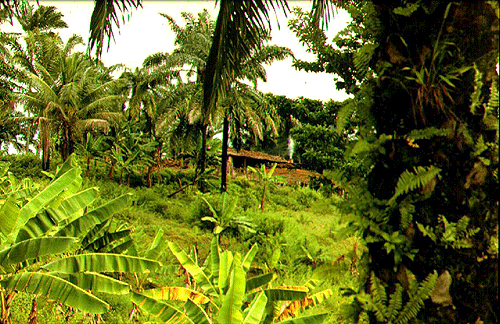 The Portuguese are the dominant influence in Brazil and Uruguay. The
official language of Brazil is Portuguese. The Portuguese were much more interested than the
Spanish in importing
foods to the new colonies to help settle the land, as well as in
exporting new" foods to
Europe. Many African slaves settled along the coastline of Brazil, where
sugar cane and tobacco
could be cultivated. Brazil and Venezuela were the only countries in South
America to import
slaves. The slaves did most of the cooking in the colonies since the
Portuguese women were too
pampered to cook so the methods and ingredients used by African slaves
have a great bearing on
the dishes of Brazil. Other influences came from the Japanese, Germans and
Italians.
The Portuguese are the dominant influence in Brazil and Uruguay. The
official language of Brazil is Portuguese. The Portuguese were much more interested than the
Spanish in importing
foods to the new colonies to help settle the land, as well as in
exporting new" foods to
Europe. Many African slaves settled along the coastline of Brazil, where
sugar cane and tobacco
could be cultivated. Brazil and Venezuela were the only countries in South
America to import
slaves. The slaves did most of the cooking in the colonies since the
Portuguese women were too
pampered to cook so the methods and ingredients used by African slaves
have a great bearing on
the dishes of Brazil. Other influences came from the Japanese, Germans and
Italians.
However. long before the slaves were brought to South America. the
Portuguese and Spanish
were once themselves both conquered by the Moors of North Africa. It was
the Moors who
introduced the Portuguese to
oranges.
lemons and
tangerines and the art of
drying fruit. Many of
the desserts eaten in Brazil are much too sweet for the tastes of
Americans. The names of several
desserts still draw you to them. such as: Big House Cookies, Hoping for a
Husband Cake and
Kisses from the Farmer's Daughter.
Wheat does not grow well in the northern parts of South America. Both the
Spanish and Portuguese being Catholic, needed wheat to make the hosts
which they served at mass. The priests used a product that the natives grew and used
it to make a
flat bread. It was
manioc, a root vegetable that was used by the natives in the jungle of
the Amazon Basin.
Besides
manioc the Brazilian Indians knew many other crops such as
corn,
sweet potatoes and
peanuts.
Coconuts grow along the coast of Brazil. but not in the deep
interior, and it is believed
that they may have come long before Columbus brought them by ocean
currents from Africa.
The Native Indians did not use the
coconuts in everyday cuisine, but with
the arrival of the slaves,
its use became more common.
Coconuts can now be found in almost every meal
and is used in every manner in Brazil.
Rice is also used in almost every meal. along
with beans of one type or
another.
Manioc powder is used in salt shakers and is present at most
tables.
The National Party Dish of Brazil is the Fiejoada Completa, a meat and
bean dish which is lavishly decorated and displayed in the shape of a horn of plenty. The
Portuguese introduced
dried shrimp to South America. The Africans became very fond of them and
used them in a
multitude of recipes, including tapas,
chicken and seafood stews.
 .
.

 The Portuguese are the dominant influence in Brazil and Uruguay. The
official language of Brazil is Portuguese. The Portuguese were much more interested than the
Spanish in importing
foods to the new colonies to help settle the land, as well as in
exporting new" foods to
Europe. Many African slaves settled along the coastline of Brazil, where
sugar cane and tobacco
could be cultivated. Brazil and Venezuela were the only countries in South
America to import
slaves. The slaves did most of the cooking in the colonies since the
Portuguese women were too
pampered to cook so the methods and ingredients used by African slaves
have a great bearing on
the dishes of Brazil. Other influences came from the Japanese, Germans and
Italians.
The Portuguese are the dominant influence in Brazil and Uruguay. The
official language of Brazil is Portuguese. The Portuguese were much more interested than the
Spanish in importing
foods to the new colonies to help settle the land, as well as in
exporting new" foods to
Europe. Many African slaves settled along the coastline of Brazil, where
sugar cane and tobacco
could be cultivated. Brazil and Venezuela were the only countries in South
America to import
slaves. The slaves did most of the cooking in the colonies since the
Portuguese women were too
pampered to cook so the methods and ingredients used by African slaves
have a great bearing on
the dishes of Brazil. Other influences came from the Japanese, Germans and
Italians.